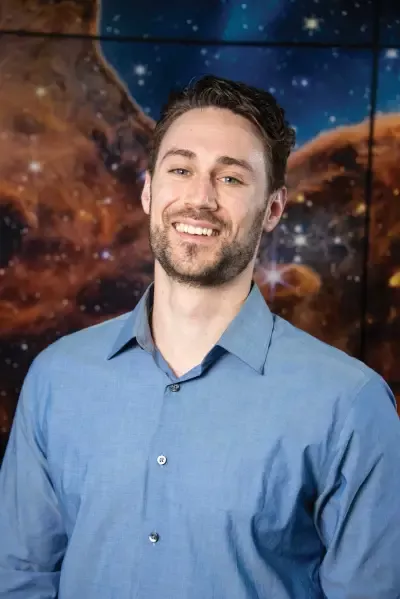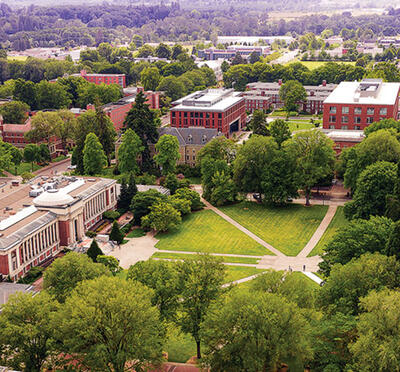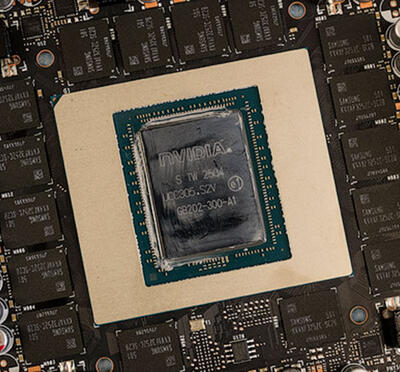Last Christmas, Amrit Nam Khalsa, B.S. mechanical engineering ’18, woke up to a wonderful gift: the perfect launch of the $10 billion James Webb Space Telescope, the largest, most complex space telescope ever built.
“I thought, ‘Finally, this is actually happening.’ Then I thought, ‘Now comes the hard part,’” Khalsa said. “The launch was not necessarily the hardest thing the telescope had to endure. There were still weeks of nail-biting deployments and positioning.”

“The first time I set foot in the high bay and looked up at the telescope, I was just 22. It’s hard to appreciate the scale until you’re right there,” Khalsa said. “You feel the energy change and you think, ‘Whoa, this is big; this is something monumental that could change our fundamental understanding of science.’”
Khalsa’s four-person team was responsible for testing and troubleshooting the telescope’s 178 nonexplosive actuators. The devices are a type of hold-down release mechanism used to secure elements of a spacecraft or its payload during launch. On command, HDRMs release to allow equipment to move into operating positions.
To fit inside the Ariane 5 rocket that carried it into space, the telescope was folded up. Critical elements, like the solar power array, communications antennae, sunshield, and mirrors were all secured by HDRMs. During Webb’s monthlong journey to its permanent station, each component had to be released and deployed in a tightly choreographed sequence. A single HDRM failure could compromise the mission.
Khalsa had moved on to his current position with Blue Origin in Seattle when the telescope launched. But, of course, he still felt a tremendous personal and professional connection to Webb. He checked for updates several times a day throughout the flight.
“Every one of those actuators was a potential point of mechanical failure that carried an insane amount of risk. So, yeah, I was a little anxious,” Khalsa said.

They all worked perfectly.
When the last segment of the telescope’s enormous mirror swung into place two weeks after launch, he felt relief and a sense of accomplishment — and then again, once the telescope reached its destination 1 million miles from Earth.
Fully deployed, the telescope looks like a giant golden honeycomb riding atop a diamond-shaped silver surfboard. Its sunshield covers the area of a tennis court, and its hexagonally segmented mirror is more than six times the size of the one on the Hubble Space Telescope. According to NASA, Webb will allow scientists to peer back 13.6 billion years, when the first galaxies formed after the Big Bang.
At Blue Origin, Khalsa is responsible for integrating payloads for the New Glenn program. According to the company, New Glenn’s massive launch vehicle will be capable of carrying people and payloads into Earth orbit, and possibly beyond.
Khalsa was a senior before he even considered a career in aerospace. “I thought, ‘Oh, I’ll just get some manufacturing job in Portland and follow that general path,’” he said.
Everything changed when the time came to choose a senior capstone project. He wanted something different and challenging, so he convinced some friends to join a team that would design and build a high-altitude rocket. And it would be yet another chance for the type of valuable hands-on learning that he’d enjoyed throughout his college career.
“I didn’t think it would lead anywhere new. It was more like something that just seemed cool,” he said. “As soon as I got started on the project, I knew instantly that I wanted a career in aerospace. I never looked back.”
He gives Nancy Squires a lot of the credit. Squires, who died in June 2021, was a senior instructor of mechanical engineering and served as the capstone project’s senior advisor. Her numerous accomplishments included spearheading Oregon State’s aerospace engineering program.
“I took some courses with Nancy. I liked the topics, and I liked her as a teacher,” Khalsa said. “Her passion for space and space exploration was inspiring, and she cared about her students in a way that I had not experienced.” Even years after Khalsa graduated, Squires would reach out periodically just to check in. “She was a mentor and a friend. She was phenomenal, and she’s the reason I found where I wanted to be.”
After Webb arrived at its final destination in late January, a series of algorithms fine-tuned the position of its 18 mirror segments, allowing them to function as a single mirror. Engineers then calibrated its instruments in preparation for initial operations. NASA released the telescope’s first images to the public over the summer.
“My entire career has taken a very different trajectory than anything I expected,” Khalsa said. “I’m just proud to have contributed to something so big.”




